#4th century CE
Text

Roman magical nails
3rd-4th century CE
British Museum
London, July 2022
#Magic#Ancient Rome#Roman#nail#inscription#bronze#3rd century CE#4th century CE#British Museum#my photo
848 notes
·
View notes
Text
So I’ve seen a few posts going around lately about philosemitism, but mostly in the context of people being called out for it, and it’s occurring to me that if you don’t have a frame of reference for it, you probably don’t understand why it’s really a very bad thing.
So I’m going to share a story that happened to me a few years ago, when I was studying for my b’nei mitzvah.
This lady pulls into my drive thru at work. She’s wearing a MAGA hat, and before I can hide my Magen David necklace—this was not that long after Charlottesville—she absolutely GUSHES “oh, you’re Jewish?” and immediately starts going on about beautiful traditions, Jesus was Jewish, yadda yadda. (All the Jews reading this are currently nodding because they’ve all met this woman at least once.)
And then she gets to the part I want to highlight for the goyim, the learning part of this:
Her: And we need to stick together, because you know what’s right in the middle of Jerusalem, right?
Me: …..the Temple? (It’s not, it’s at the city’s edge, but I could see someone hearing “center of religious and cultural life” and making an assumption.)
Her: no!
Me: …….the Knesset?
Her: no! How do you spell Jerusalem?
Me, thinking she saw the Hebrew book next to me: yod-reish-shin-lamed—-
Her: no, no! U-S-A! J-E-R-U-S-A! The United States is part of Israel!
Y’all.
This woman.
Legitimately believed.
That “Jerusalem.”
Was the name.
Of a Jewish city.
In a language.
THAT DOES NOT HAVE A “J” SOUND.
She literally told me I was wrong when I pronounced it Yerushalayim, which is the Hebrew transliteration of the older “Urusalim,” which is the original name of the city in the Canaanite languages circa 1500 BCE. (An even older inscription has been found in Egyptian, but it’s a little wonky because the two languages didn’t have the exact same sounds—think of how an English word spoken by a Japanese person and then transliterated as they said it would look.) “Jerusalem” as a form literally cannot occur until after the word has filtered through Latin and into English—at the earliest, the 3rd or 4th century CE—because there’s no J in Latin, either.
THIS is philosemitism: this woman wanted so badly for Judaism to be her fun toy that she completely ignored Jewish reality. We weren’t actually people to her; we were a thing for her to exotify. When actual Jewish experience refuted her she ignored it, but many philosemites will get angry when they’re faced with reality.
If you’re thinking “wow, that sounds a lot like fetishization,” you’re right, because it is. It’s fetishization crossed with the kind of “support” a lot of people offer the queer community, where they love it when it’s waving rainbow flags and “oh my g-d, girl, slay,” but the moment it’s anger over the STD crisis or the underserving of homeless queer youth, they dip. They’re only around while it’s ~*~*~aesthetic.~*~*~
Philosemitism isn’t “loving Jews too much.” It’s loving a stereotyped ideal you put on a pedestal, and not allowing for diversity of Jewish experience.
419 notes
·
View notes
Text
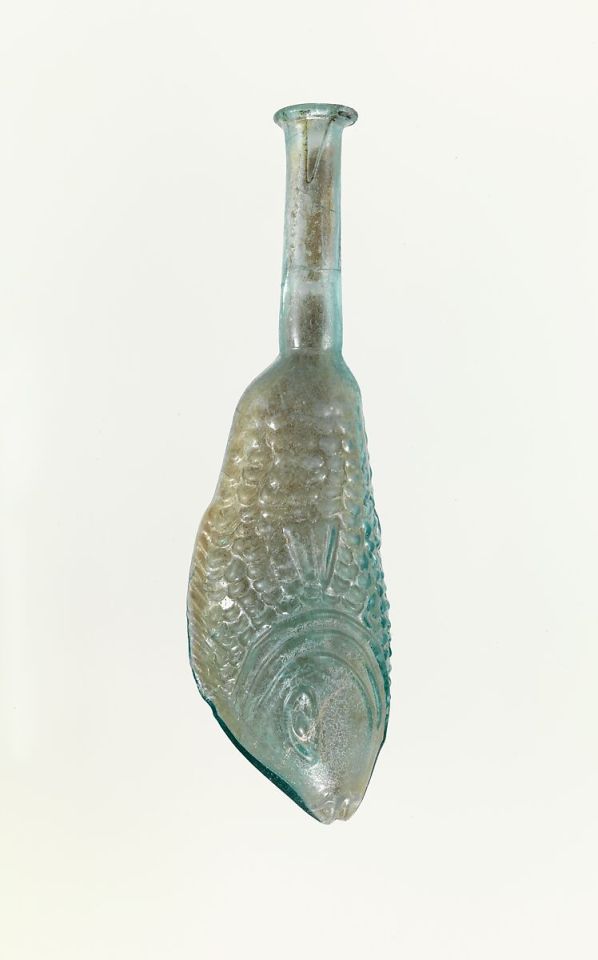


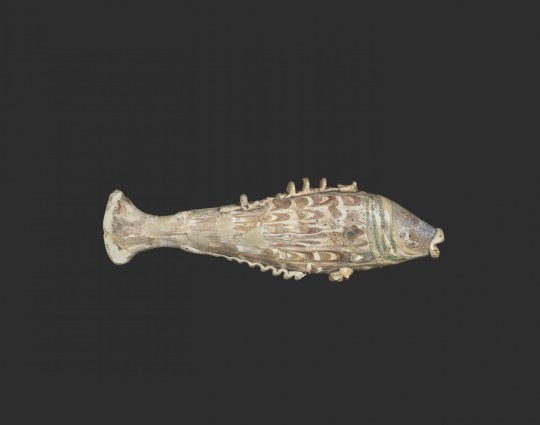
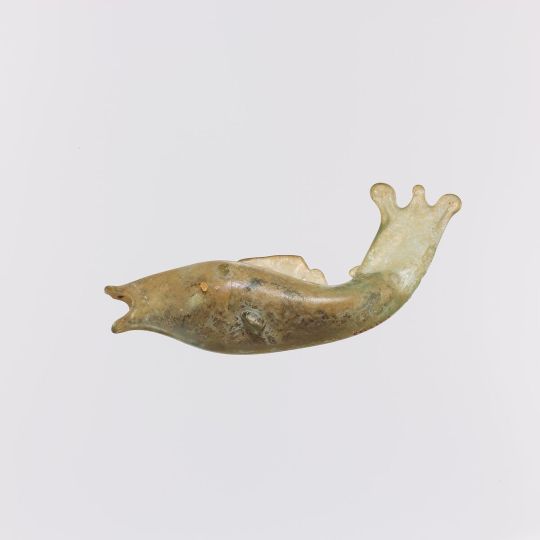
Roman glass bottle in the shape of a fish, 1st–2nd century CE.
Roman carved rock crystal fish, 1st Century CE.
Roman glass dish cover in the shape of a fish, 1-99 CE
Glass fish, Eastern Mediterranean during the Roman Empire -199 CE or later
Roman glass bottle in the shape of a fish, 4th century C.E.
#ANOTHER FAILURE TO STAY ON THEME but there is a great deal of comfort and delight in looking at ancient animal shaped objects#glass art#ancient rome#fish#roman empire
787 notes
·
View notes
Text


help carthage and coins featuring 4th century CE roman emperors have taken hold of my brain and won’t let go
#shoutout to trade based empires and their trading partners bc it’s doing a lot of heavy lifting for all these textile patterns etc#I can’t recreate Carthage but I sure can create positive space around the negative space where Rome fucking destroyed it
336 notes
·
View notes
Text
🧭 8th House: Your Biggest Challenges in Astrology 🧭

[You can book a personal reading with me, kindly check the pinned post <3]
Masterlist: All my astrology posts at one place

8th House in Astrology rules over everything that is the considered to be the challenging parts of life. It has positive connotations in a way that through these challenges we find our brightest light. The lessons in the 8th house present themselves through our connections with other people, whether its physically, mentally, emotionally or even spiritually. Because through our connection with others we learn about life. 8th house is also connected with debts, other people's resources, being involved in drama, but that's a topic for a different day. Let's see how you can use your 8th house to navigate your challenging lessons, so that the outcome is positive and growth oriented.
See where the ruler of your 8th house falls:
Check 8th House Sign (ex. Libra) -> Sign's Planetary Ruler (ex, Libra is ruled by Venus) -> Which house the ruler falls into (ex, Venus in 4th House)
The signs and their rulers: Don't use Uranus, Neptune and Pluto as rulers of any signs. Firstly it lack proper credits, and second it's just not it (found after 1700s). We rather rely on the Traditional Astrology that has been around for millenias (since about 2nd Century CE). It just makes so much more sense (I'm going to make a long detailed post about this).
Aries, Scorpio: Mars
Taurus, Libra: Venus
Gemini, Virgo: Mercury
Cancer: Moon
Leo: Sun
Sagittarius, Pisces: Jupiter
Capricorn, Aquarius: Saturn
If you have your ruler of the 8H in the 1H, all the lessons that you experience lead you back to yourself. It's an extremely self-development oriented aspect. Your challenges and lessons shape the way you view the world. So whenever such lessons strike, seek to understand how it alters the way you understand reality and life itself. These challenges are presented to you so that you can understand no one but yourself, better. You might have a bit of insecurities and self esteem issues, that result from challenging experiences. Seek to nurture yourself in whatever way you feel the most comfortable, and put your beliefs + values first and foremost.
If you have your ruler of the 8H in the 2H, you are here to practice healthy give and take. You experience people meddling in your business all the time. Perhaps you are always stuck with people using your for your resources or material possessions or simply taking more from you than they can ever return, vice versa. Your lesson is to prioritize yourself, but also not be greedy or manipulative with others. Try to not overly attach with material outcomes, and you shall see a much better flow of finances, resources, etc. Seek healthy ways of intermingling with others, of trading and making deals. Don't lessen your personal value for anyone.
If you have your ruler of the 8H in the 3H, your biggest lesson is to express your thoughts and ideas in a better way. If you have your Mercury here *as the ruler, then it means literally speech issues like stammering or even difficultly concentrating. If you have Moon here *as the ruler, then inability to express your emotions into words. Beware of gossip or spreading misinformation, and also consuming information that is unverified or unconfirmed, since you are much more prone to issues with miscommunication. Seek journaling or writing as it can help you regulate all those thoughts in a better way. And don't hold yourself back from speaking up.
If you have your ruler of the 8H in the 4H, you have this sense of privacy that you seek to protect at all costs. The issues you regularly struggle with have to do with being vulnerable and not being able to open up, or opening up too much with anyone. There could be issues with the home and family life, perhaps there are people constantly prying over your personal life or violating your boundaries, or some of your family members being a pain in the butt. There are many ways to tackle these issues, but the best one is too have proper and healthy boundaries, because you are not everyone else's business. Seek close and trusted people to confide in.
If you have your ruler of the 8H in 5H, you might struggle a lot with either being too serious or not being serious at all when it comes to life's pleasures and fun. Striking a balance is the key. People also take advantage of your light-hearted nature, therefore your must have healthy boundaries that allows you to protect your creative and happy space. People can meddle between your kids or your creative endeavors. Your biggest lessons come from you learning how to rely on your creative self expression. Do not be afraid to shine. Your light is very strong and you deserve to feel the best. Seek to explore cool forms of expression and prioritize your inner child.
If you have your ruler of the 8H in 6H, you are meant to prioritize your routines and learn how to be a more grounded/organized/productive person. The thing is you don't need to burn yourself out or push yourself to do tasks/things that simply aren't working out, just for the sake of it. Instead, set systems that actually suit you. Do not make grand resolutions that you actually cannot put to ground. You have a bit of challenge with the material realm, either being too obsessed with perfection or being super disorganized. Some can even have a bit of health issues. Seek balance and create a healthy lifestyle that you actually enjoy living with. Build systems and not routines.
If you have the ruler of your 8H in 7H, most of your challenges and transformative situations in life has to do with others. These could be relationships, partnerships, friendships and family. Through people, you learn and grow. If you have your Venus in the 7H *as the ruler of 8H, you experience very life changing things in regards to romance and building connections with others. If you have Mercury in the 7H *as the ruler of the 8H, you experience difficultly expressing yourself with others. If you have Moon in the 7H *as the ruler of the 8H, you may have attachment issues. So seek healthy forms of communication, expression, etc. Try to learn the healthy patters of being in relationships and don't hold onto people that stall you from moving forward. Easier said than done, but even being aware of yourself helps a ton!
If you have the ruler of your 8H in 8H, you might go through a lot of shitty situations, but you are tough af. This is actually a pretty good aspect because your challenges don't leak to other areas of your life. The only area it affects, ie, the 8H, is about getting involved in other people's lives deeply, psychology and the occult. So you may resort to things like shadow work, alternative healing, etc, to help you transmute all this shadow into light. With this aspect you need to make sure that you don't make 'healing' your entire identity or make your pain your identity, especially if you have a major planetary ruler such as Sun or Moon. You are here to learn about the deeper parts of life, and that is not always dark and shadowy. Sometimes the lessons you learn from other people can be your most motivating teachers in life. So, take it easy. It happens for you, not to you.
If you have the ruler of your 8H in the 9H, you are here to literally find the light at the end of the tunnel. If the 8H is about the shadow, 9H is about the light. Your lessons give you a really big opportunity to go towards the brighter side of things. And at the same time these lessons are very much ingrained with becoming more open minded with life, being interested in learning about life on a higher level such as philosophy or self development. On the other hand, these challenges can also be related with foreign travel, other cultures, higher education, global media platforms, philosophy, etc, so make sure you tackle these accordingly. You struggle more with letting go and getting "lucky" in life because you tend to get comfortable in the uncomfortable side of life. Seek to expand beyond your challenges, and resolve painful situations by connecting with your spiritual/religious side.
If you have the ruler of your 8H in the 10H, you biggest challenges steams from your career and public reputation. You tend to be a bit more secretive about your life when out in public, or simply view others as prying on your private life. People might become manipulative with you when it comes to your career and you might be prone to people spreading batshit about you all the time. There are a lot of ways these events can be tackled, but one of the advice is to not let others know information about your work or achievements unless they are someone you trust A LOT. People can use you to gain some type of fame or take credit for things they didn't even do. You publicly go through tough things, whether that 'public' is just relatives or a few friends/acquaintances. People always get to know about your challenges and lessons for some reason. So, be careful of how much you let random people know.
If you have the ruler of your 8H in the 11H, you experience a bit of similar situation as the ones who has their ruler in the 10H, but the difference is, people use your issues to propel themselves forward in some way or the other. For the 10H persons, people only spread rumors about them and talk about their issues. But for you, people use it to their advantage. You might have a bit of challenge with making genuine connections with others, as in networking and socializing (not personal relationships). These people can use you to advance their career, use and exploit your ideas and work to give themselves a boost. And you might also struggle with creating long term plans and holding your visions. So the advice for the manipulative people part is that hold on until you actually know that someone is trustworthy. And even then, don't tell them everything about your plans and your dreams. 11H or not, some people are very quick to take advantage of our dreams.
If you have the ruler of your 8H in 12H, first of all I want to do is give you a big hug! *sending a virtual hug*. The reason I say this is because both these houses have a reputation for bringing a lot of intense and transformative situations in a person's life in a variety of ways, but not everyone is able to instantly identity these toxic patterns and help themselves get out of it. With this placement your biggest challenges have a deeply rooted karmic hint to them. And almost all the time, it requires for you to understand what that karma is and end that cycle so that you can grow. Based on the planetary ruler in the 12H your situation can be the most intense to least intense, but what is asks for you is to identity the subconscious/subliminal patterns that keep you stuck in life, and transmute them into healing. Take it easy, don't make 'healing' your entire identity. Focus on grounding and your well-being, first and foremost.
Thank you for reading! Stay tuned for more Astrology content 🏹✨️!
#astrology#8h placements#8th house#natal chart reading#astrology readings#astrology chart readings#natal chart#astrologer
1K notes
·
View notes
Text
Timeline of Occult Figures
Here is a non-exhaustive list of people you will likely come across in researching anything under Occultism.
These dates are not going to be 100% accurate because many of these folks have either lied about their age or for some reason or another we don't have solid records of them.
---
Pythagoras 570-490 BCE
Socrates 470-399 BCE
Plato 424/5-348/7 BCE
Aristotle 384-322 BCE
Apollonius of Tyana 15-97 CE
Pliny the Elder 23/24AD-79CE
Ptolemy 100CE-170CE
Galen 129-216CE
Zosimos of Panopolis ~beginning of the 4th century
Roger Bacon 1220-1292
Henry Agrippa 1486-1535
Nostradamus 1503-1566
John Dee 1527-1608
Paracelsus 1593-1608
Jacob Grimm 1785-1863
Eliphas Levi 1810-1875
Helena Blavatsky 1831-1891
A. E. Waite 1857-1942
Margaret Murray 1863-1963
Aleister Crowley 1875-1947
Gerald Gardner 1890-1946
Robert Graves 1895-1985
Austin Osman Spare 1886-1956
Scott Cunningham 1956-1993
---
This is a re-upload because I can't find the original post I made so any additions made on that post have been lost. Please let me know if you have suggestions!
211 notes
·
View notes
Note
wtf even is hermeticism? I heard of a comic book that showcases hermeticism, and it turns out it was mostly cabala and some stuff about higher dimensions, and the fuzzy line between stories and reality.
The thing about the fuzzy line between stories and reality cropped up in a youtuber's analysis of a different comic book series that revolved around hermeticism, like empowering yourself by telling a story.
Is it like, tricking reality into being a different way by acting on the basis of the Nous?? Is that how Hermes Trismegistus became a god, by ascending to and becoming one with the Nous/Monad/whatever?
If he never existed, the stories about him created him, on the basis of the Nous?
Hermetica is a body of ancient texts attributed to Legendary Sage Hermes Trismegistus. They're extremely difficult to date, and you see guesses anywhere from the 4th century BCE to the 4th century CE.
Hermeticism is quite eclectic. It exists as a blend of Greek, Egyptian, and Jewish, and other north-African mythologies and philosophies all rolled into one. The important thing to remember, is that Trismegistus is portrayed as being the source of all wisdom ever forever. All knowledge came from him. Everything cool or interesting about Egyptian, Greek, or Jewish theology is supposed to be his doing.
Hermeticism is a blend of several different religious currents that would be difficult to summarize in a tumblr post, but Hermetic doctrine is honestly less important than HOW Hermeticism syncretizes these disparate currents into a single theology. Its VERY good at sniffing out similarities between theologies, and gluing them together. Additionally, it really likes math. Hermeticism is really good at using math and science to reinforce its mythology.
So when people say "Hermetic" they generally mean one of three things:
1 - Classical Hermetica, as in the ancient body of work attributed to Hermes Trismegistus.
2 - Renaissance Hermetica. The theology was lost for a hot minute, and reintroduced to Europe in the 15th century via a weird Italian named Ludovico Lazzarelli. This was the first guy to identify as a "Hermetic Christian." (There were also some Islamic mystics around the 8th-10th century who really liked Hermetica, but they're oddballs even by the standards of Islamic mystics. #isma-ilimoment)
3 - "Neo-Hermeticism" This is the version of Hermetica that came back in the 17th-18th century. This is where you got folks like the Hermetic Order of the Golden Dawn, who rediscovered just how good Hermetic theology was as a conceptual mortar. They just went hog-wild with it. That's where you get "Hermetic Quabbala." Europe at the time had just seen an explosion of interest in ancient Egypt, and thats why a lot of Quabbalistic texts have a bunch of Egyptian stuff.
So the stuff about higher dimensions and the lines between reality and fiction? That sounds like 1970s Chaos Magic, which itself was highly influenced by Hermetica, specifically Neo-Hermeticism.
As for the nature of Trismegistus himself, even classical Hermetica has like nine different backstories for him. Depending on the text, hes Hermes, Thoth, a combination of Hermes and Thoth, a normal sage who was very wise, a man who achieved godhood, the tutor of Moses, etc, etc. There's no set mythology for Trismegistus beyond "Legendary Sage of Sages."
I'm gonna plug my patreon here because I'm writing about Trismegistus in an alchemical context on Patreon right now.
337 notes
·
View notes
Text
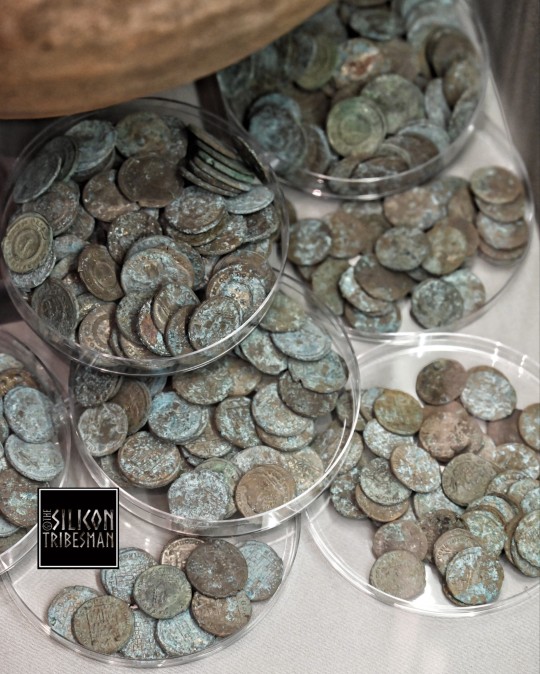
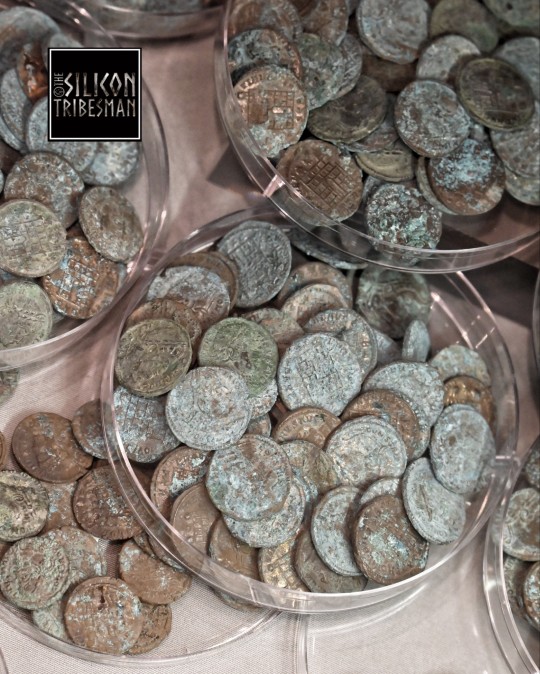
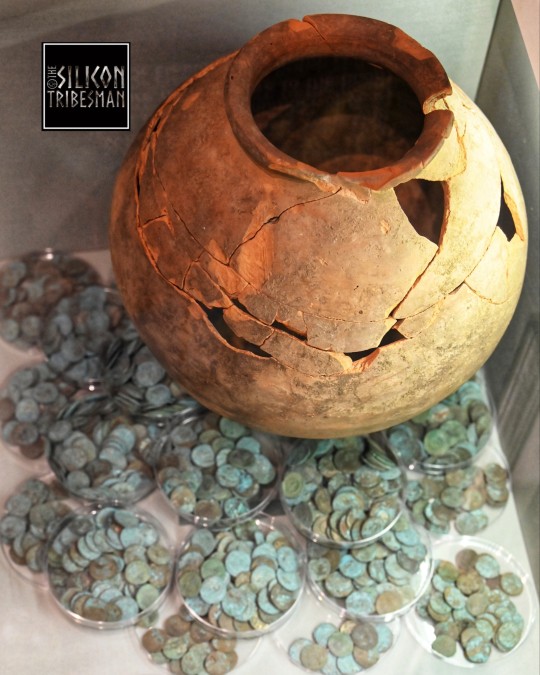

'The Shrewsbury Hoard' 4th Century CE Roman Hoard, Shrewsbury Museum, England
#roman army#roman hoard#roman#romans#roman coins#roman soldiers#roman pottery#roman wealth#hoard#archaeology#Shrewsbury#metalwork#metalworking#artefact#roman living#roman britain
288 notes
·
View notes
Text

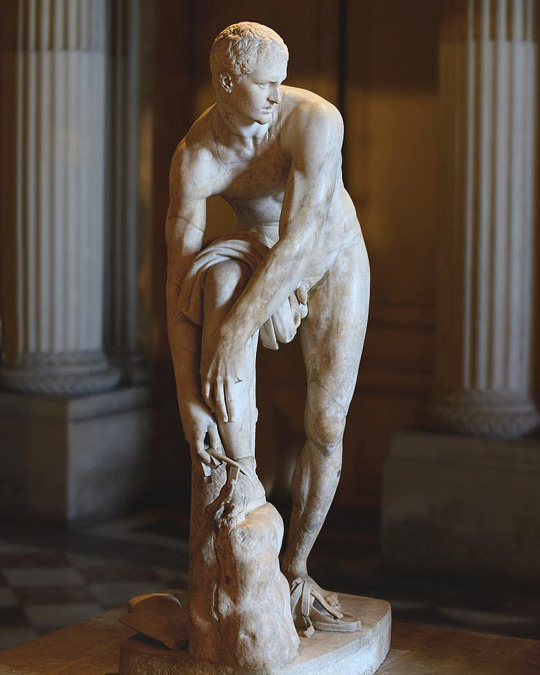
“Hermes fastening his sandal (Cincinnatus)”. Roman copy (2nd cent. CE) from Greek original by Lysippos (4th century BCE). Musée du Louvre, Paris. Pentelic marble.
193 notes
·
View notes
Text

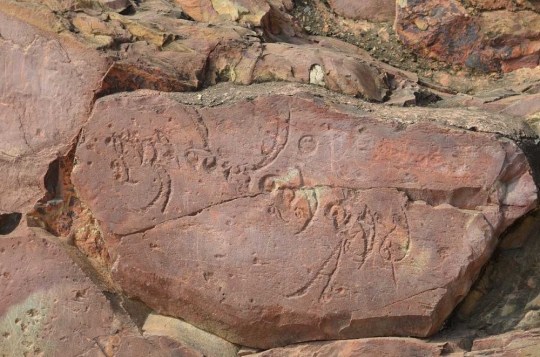
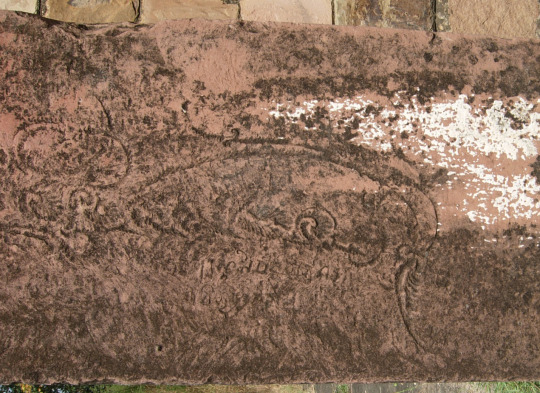
Shankhalipi (IAST: Śaṅkhalipi) or "conch-script" is a term used by scholars to describe an undeciphered, highly calligraphic Brahmic script that resembles spiral seashells which can tentatively be assigned a new script family. They are found in inscriptions across various parts of India except the far south and date to between the 4th and 8th centuries CE. Both Shankhalipi and ornate Brahmi were stylised scripts used primarily for names and signatures. Examples of this script have been found as far away as Thailand and Indonesia.
307 notes
·
View notes
Text

Roman glassware
* Romano-Germanic Museum, Cologne
* coloured glass, hence 3rd or 4th century CE.
* Local workmanship IIRC
Cologne, November 2017
#Roman#glassware#3rd century CE#4th century CE#ancient#art#Germany#Cologne Romano Germanic Museum#my photo
46 notes
·
View notes
Text

The piercing gaze of the ancient Greeks.
A collection of some famous Greek sculptures looking directly at...you
From left to right:
1) Antikythera Philosopher, 250 BCE
2) Athena of Piraeus, 4th century BCE
3) Head of Hygeia, 5th-4th cen. BCE
4) Antikythera Ephebe, 4th cent. BCE
5) Unknown man from Delos, c. 100
BCE
6) Head of a Goddess, 2nd cent. CE
📸 ArysPan
#dark academia#light academia#academia aesthetic#classical#academia#escapism#classic literature#books#books and libraries#architecture#greek#statue#sculpture#eyes#antikythera#Athena of Piraeus#Head of Hygeia#royal core#cottage core#aesthetic
904 notes
·
View notes
Photo








Pre-colonial Native American cities/settlements/meeting sites.
Sivan Vahki: just north of Casa Grande, Arizona, Sivan Vahki or Siwañ Waʼa Ki: was a large farming and trade network site of the Sonoran Desert people starting in the early 13th century.
Werowocomoco: With habitation beginning from the 13th century, Werowocomo was a village that later served as the headquarters of the werowance Wahunsenacah, Paramount Chief of the Powhatan confederacy.
Cahokia: Mississippian culture city dating from circa 1050–1350 CE, containing elaborately planned community, woodhenge, mounds, and burials.
Tenochtitlan: built atop a lake, Tenochtitlan was an Aztec altepetl, and was the largest city in the pre-columbian Americas at its peak. It is considered one of the most impressive cities in North America, and is today known as Mexico city.
Tikal: one of the most powerful ancient kingdoms of the Maya, and dates back as far as the 4th century BC, and may have had a population of up to 90,000.
Omahkoyis: Meeting place and trading and cultural hub for the Blackfoot, and later other tribes as well as settlers. The Blackfoot and their ancestors had inhabited the area as early as 12,000 BC, and would later also be known by other names. Colonizing efforts turned the area into a settlement, known today as the city of Edmonton.
Qusqu: also known as “Cuzco”, the city served as the capital for the Inca Empire from the 13th century up into the 16th century upon colonization. However, evidence shows that The Killke people occupied the region from 900 to 1200 CE, prior to the arrival of the Inca, and had constructed a fortress about 1100 CE.
Uttewas: later known as “Old Masset”, was one of the largest Haida villages on Haida Gwaii, and is home to a number of important cultural artifacts, such as numerous totem poles. Today its land is legally designated as Masset Indian Reserve No. 1.
#historyedit#Native American history#canadian history#american history#mexican history#peruvian history#cahokia#tenochtitlan#tikal#maya#aztec#nahua#history#justin's edits#ndn#native american
933 notes
·
View notes
Photo

Laocoön: The Suffering of a Trojan Priest & Its Afterlife
The sculpture group of Laocoön and His Sons, on display in the Vatican since its rediscovery in 1506, depicts the suffering of the Trojan prince and priest Laocoön (brother of Anchises) and his young sons Antiphantes and Thymbraeus and is one of the most famous and fascinating statues of antiquity. In his Natural History, Pliny the Elder states that the Laocoön, created by the eminent Rhodian sculptors Hagesander, Polydorus, and Athenodorus, “is a work of art to be preferred to any other painting or statuary” (36.37). Among art historians, the sculptural group has received near-universal acclaim ever since its rediscovery under questionable circumstances in 1506.
Is the statue famously shown since its discovery in the newly designed Belvedere Garden at the Vatican Palace actually the ancient sculpture mentioned by Pliny, or rather a clever Renaissance forgery? If the latter, who may have contrived this masterful deception? If the former, is it an original, or a marble copy of a Hellenistic bronze made for a Roman patron?
Beware of Greeks Bearing Gifts
In the most famous version of the story, as told by Virgil (70-19 BCE) in his Aeneid, Laocoön had warned his fellow citizens against the Greeks “even if they bear gifts,” and had tried to expose the true nature of the wooden horse by striking it with a spear (the wooden horse in question, of course, being the notorious “Trojan Horse”, left by the Greek forces on the coast so as to provide access into the city to the troops hidden inside the construction). When later two serpents emerged from the sea to kill the priest and his sons, the Trojans interpreted their horrific deaths as an act of divine retribution and promptly decided to move the wooden horse into the city, believing the contraption to be an offering to Minerva (Athena).
According to Arctinus of Miletus, the earliest tradition of the tragedy (surviving only through later citations), Apollo had sent the two serpents to kill Laocoön and only one of his sons; while the later author Quintus of Smyrna maintains that the serpents killed both sons but spared the father.
Servius, another late authority (c. 400 CE), tells us how Laocoön managed to incur the wrath of Apollo by sleeping with his wife before the cult statue in the god's temple. An even later source, the Byzantine scholar Tzetzes, adds that the scene of Laocoön's death took place in the very temple of the Thymbraean Apollo – appropriately setting the punishment at the scene of the crime.
The 5th-century BCE Greek playwright Sophocles produced a tragedy on the subject, of which only a few fragments survive in later citations. Apart from the sources mentioned above, Hellenistic poets Apollodorus and Euphorion, the historian Dionysius of Halicarnassus, the Roman novelist Petronius, the Latin fables attributed to Hyginus, and a few other fragments, all provide various details of the tragic story.
Despite this appearance in ancient literature from the post-Homeric to Byzantine traditions, artistic representations of Laocoön's suffering are few and far between. Depictions appear in some Greek vase paintings (5th to 4th centuries BCE) and in two frescoes at Pompeii (c. 25-75 CE). The marble statue group of Laocoön and His Sons, therefore remains the most exceptional portrayal of only a handful of ancient works illustrating the suffering of Laocoön.
Continue reading...
59 notes
·
View notes
Text

Mosaic depicting a peacock from the city of Antioch, 3rd-4th century CE. Peacocks were a frequent subject of Roman artists; they represented spring and rebirth and were kept in the temples of Juno.
{WHF} {Ko-Fi} {Medium}
377 notes
·
View notes
Text
Ancient d20s
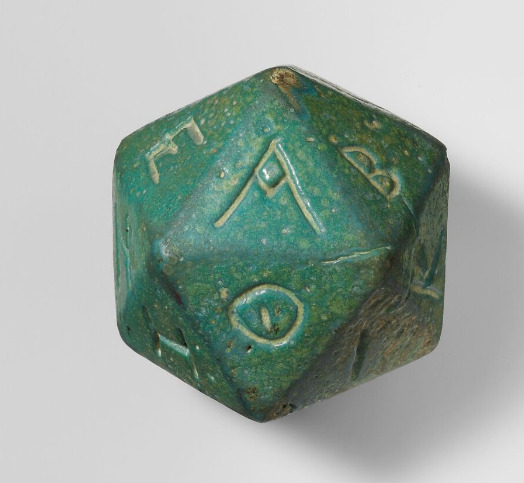
Faience icosahedron inscribed with letters of the Greek alphabet. Roman, 2nd-3rd century CE. Used for do-it-yourself fortunetelling.
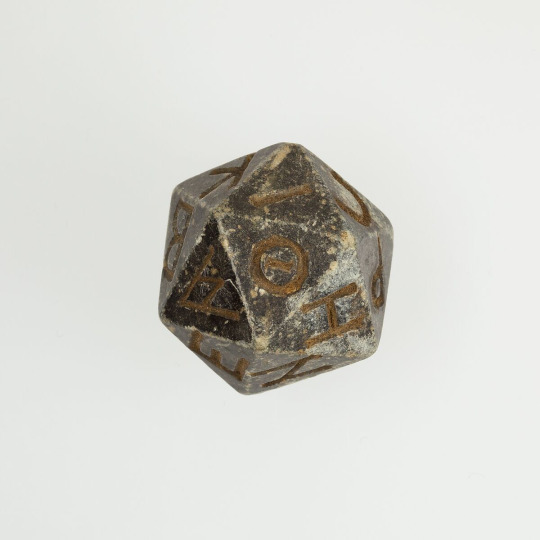
Serpentinite icosahedron inscribed with the letters of the Greek alphabet. Ptolemaic-Roman Period of Egypt, between 2nd century BCE and 4th century CE.
282 notes
·
View notes